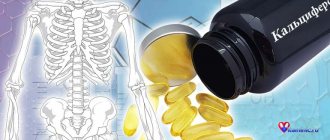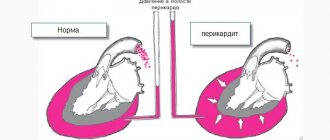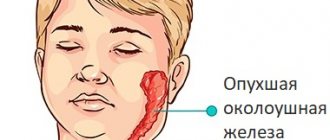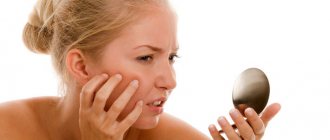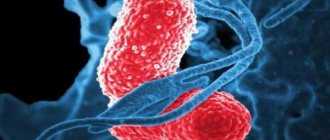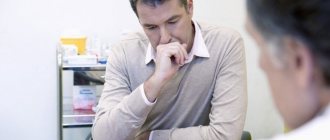Regular intake of iodine is important for the regulation of the endocrine system in the human body. If there is a lack of iodine in the body, then a number of characteristic symptoms will indicate this problem. By “listening” to your body, you can notice deviations on your own, without the help of specialists. According to statistics, about a billion people suffer from iodine deficiency worldwide. Without controlling the supply of microelements, ignoring characteristic symptomatic manifestations is the first step in the development of pathological processes.
Features of iodine absorption
Testing the thyroid gland is necessary when the question arises of how to determine iodine deficiency in the body. An examination will be carried out by an endocrinologist who will refer you for appropriate treatment.
Iodine is not produced in the human body, so it must be obtained from the outside. Its absorption is also very important. This compound can be obtained from food or medicine. They improve its absorption: cobalt, manganese, copper and selenium, “wash out” - bromine, fluorine, chlorine.
To find out if you have enough iodine in your body, you can do a test at home. To do this, you need to moisten a cotton swab in a 5 percent iodine solution and draw 3 stripes of different thicknesses (from the thinnest to the most distinct) in the forearm area. It is recommended to carry out these actions at night before going to bed, and evaluate the results in the morning. If there are 2 strips left, it means that iodine levels in the body are normal. The remaining 1 band indicates developing iodine deficiency. If all the stripes disappear, you must visit an endocrinologist.
Treatment
Since iodine levels are directly related to the state of the thyroid gland and hormone production, an endocrinologist usually deals with the treatment of iodine deficiency. A nutritionist can treat a deficiency if it does not manifest itself clinically.
It is strictly forbidden to treat iodine deficiency on your own, since there are variants of the disease when iodine compounds only aggravate the condition of the thyroid gland.
If the endocrinologist decides to compensate for the deficiency of a microelement with the help of medications, then the following drugs are usually prescribed:
- Iodomarin. The active ingredient is potassium iodide. Release form: 200 mcg tablets. Suitable for children, teenagers, pregnant women. Can be used for the prevention of endemic goiter and after surgery on the thyroid gland.
- Microiod. Ingredients: iodine—0.0005g, potassium iodide—0.005g, valerian root—0.05g. Used for thyrotoxicosis of the thyroid gland.
- Antistrumin-Darnitsa. Composition: 1 tablet contains 1 mg of potassium iodide. The drug can be used in all categories of the population to prevent iodine deficiency.
All medications are taken only with a doctor's prescription.
Symptoms of iodine deficiency
For symptoms of iodine deficiency in the body, visiting a doctor is paramount. This will help avoid a number of negative consequences for the thyroid gland. Early signs of iodine deficiency in the body in an adult are similar to the manifestation of vegetative-vascular dystonia. The disease manifests itself as a whole complex of functional disorders:
- Unpleasant tingling in the heart area;
- Cardiopalmus;
- Sweating alternating with chilliness;
- Headache;
- Fainting state.
This can lead to neuroses, arterial hypertension, disruption and deterioration in the quality of life.
Modern aspects of diagnosing hypothyroidism
An endocrinologist is involved in identifying this condition. He may order the following types of studies:
- ultrasound examination of the thyroid gland to determine its structure and size, identify tumor formations;
- determination of blood concentrations of thyroxine (T4) and triiodothyronine (T3), thyroid-stimulating hormone (TSH). Hypothyroidism is characterized by a decrease in the level of T3 and T4, an increase in TSH, for the subclinical form - only an increase in TSH;
- detection of antibodies to thyroglobulin and thyroid peroxidase - for the diagnosis of malignant neoplasms and autoimmune thyroiditis;
- biochemical blood test, namely lipid profile (cholesterol, low-density lipoproteins, triglycerides, etc.). An increase in all indicators above the norm is typical;
- scintigraphy of the thyroid gland with the introduction of an isotope of iodine or technetium - allows you to identify active and inactive nodules, as well as determine the size, location of the gland and other diffuse or focal changes in the organ;
- fine-needle biopsy is a minimally invasive technique that allows you to take thyroid cells for further microscopic examination.
Currently, in the Russian Federation and a number of other countries, neonatal screening on the 4th or 5th day of the baby’s life is used to determine congenital hypothyroidism.
Symptoms of deficiency in women
A woman's health especially depends on her hormonal levels. Signs of iodine deficiency in women are similar to the clinical picture for this condition in men. In addition, there are menstrual irregularities, decreased libido, and possible development of anemia and infertility. Women complain of extreme fatigue and irritability.
External signs appear in the form of loss of shine and beauty of hair. Nails peel and become brittle. The facial skin becomes grayish and premature wrinkles appear.
The immune system suffers, frequent colds follow one after another. Weight gain, despite grueling workouts in the gym, is even more annoying. As a result, loss of strength, depressive state, inability to concentrate.
Lack of iodine in pregnant women can lead to the death of the fetus or disruption of its development, so the expectant mother especially needs to monitor the iodine content in her body.
Iodine deficiency in pregnant women
During pregnancy, a woman needs an increased dosage of iodine, which is associated with the formation of the thyroid gland in the unborn child. The daily norm is 250 - 300 mcg. Iodine deficiency that occurs during pregnancy can cause miscarriage, thyroid dysfunction, or the development of cretinism in the child. Therefore, during such a crucial period, a woman should monitor the level of iodine in her own body. Seek advice from a doctor regarding the use of medicines containing high levels of the substance in question.
Why is hypothyroidism dangerous? Effect on pregnancy
Due to significant metabolic disorders, the following may develop:
- myocardial infarction and pulmonary embolism at a young age due to lipid imbalance and early formation of atherosclerosis;
- heart failure;
- acute cerebrovascular accident;
- fatal heart rhythm disturbances;
- hypothyroid (myxedematous) coma, which is characterized by a drop in blood pressure, hypothermia (in some cases, levels can reach 30°C), a decrease in heart rate and respiratory movements, intestinal obstruction due to a critical violation of peristalsis, acute urinary retention, and changes in consciousness. Mortality without proper therapy reaches 75%;
- serious disorders of the immune system and, as a consequence, the addition of severe infectious diseases - pneumonia and others.
Recently, scientists have proven that hypothyroidism significantly increases the risk of developing malignant breast tumors.
During pregnancy, the manifestations of hypothyroidism may increase, but, fortunately, this does not happen so often.
But there is always a risk:
- premature birth;
- spontaneous abortions in the first and second trimesters;
- miscarriages in the third trimester;
- malformations of the heart and other internal organs.
Signs of iodine deficiency in children
Lack of iodine in children leads to poor appetite, fatigue, and frequent colds. When a severe stage of hypothyroidism occurs, inhibition occurs in physical and mental development, and there is a risk of developing cretinism. Iodine deficiency can become hereditary if a pregnant woman neglects the advice of the supervising doctor. Also, smoking by the expectant mother reduces the concentration of the element in the body, which will also lead to disastrous consequences.
Symptoms of iodine deficiency in the body in adolescents include the following:
- mental retardation;
- speech deviations;
- loss of consciousness.
With normal functioning of the thyroid gland, iodine deficiency can often provoke malfunctions of the thyroid gland; in most cases, endemic goiter occurs. Its obvious sign is that it looks like a swollen, protruding lump. You should monitor the child’s condition and periodically test for the content of the element in the body.
Vitamins
Deficiency of iodine and other elements in a woman’s body can be compensated with the help of multivitamins. This is especially useful for people who live far from the sea and eat little seafood.
- Complivit Multivitamins. The drug contains 11 essential vitamins and iodine. Can be taken by children over three years of age.
- Centrum from A to zinc. The drug contains important vitamins, minerals, amino acids. Potassium iodide content - 100 mcg per tablet.
- Multitabs classic. Ingredients: vitamins, amino acids, minerals. The content of potassium iodide is 150 mcg per tablet.
Vitamins contain small amounts of iodine compounds, so they can be taken without danger. But you need to pay attention to the number of other components.
Signs of deficiency in men
Lack of iodine is equally acute in both men and women. However, for the former, the need for this element is much lower.
Symptoms of iodine deficiency in the body in men:
- general weakness, fatigue;
- memory impairment;
- drying of the skin;
- hair loss;
- heart problems;
- gastrointestinal disorder;
- tremor of the limbs;
- disruption of the nervous system;
- problems with potency;
- possible development of infertility;
- swelling of the mucous membranes;
- painful sensations in the spine, head;
- development of depression;
- obesity;
- increased sweating/chills.
If iodine deficiency is not treated, the thyroid gland may become enlarged in the body. As a result, coughing, difficulty swallowing, and attacks of suffocation may appear. Sexual activity decreases, and with a significant shortage it can lead to impotence.
Treatment of hypothyroidism depending on the cause of the disease
There is only one treatment for hypothyroidism, and it is hormone replacement therapy. Levothyroxine, Euthyrox, and L-thyroxine are currently used. Dose selection depends on the cause and general condition of the patient.
For example:
- the standard requirement is 1.6 mcg of the drug per 1 kg of weight, the TSH level should be from 0.5 to 2 mU/l. Control is carried out once a year;
- in persons with cardiac pathology, treatment is carried out under the control of electrocardiography and begins with minimal doses, since thyroid hormones increase the myocardial oxygen demand. In some cases, there is a deterioration in the course of the underlying cardiac disease, especially coronary heart disease;
- During pregnancy, the dose is doubled with a subsequent decrease in the postpartum period. Maternal thyroxine is very important for the development of the child, since the presence of its normal level directly affects the mental abilities of the unborn baby;
- for subclinical hypothyroidism, treatment is prescribed individually, depending on the patient’s general well-being and the presence of other pathologies. During pregnancy, thyroxine preparations are prescribed immediately;
- in patients with adrenal insufficiency, Levothyroxine is prescribed only after its compensation, since early treatment with thyroxine drugs can contribute to a serious complication - Addisonian crisis;
- in iatrogenic forms, for example, amiodarone-induced, this drug is discontinued and another antiarrhythmic drug is prescribed. Postoperative hypothyroidism requires lifelong prescription of thyroid hormones.
Triiodothyronine is not currently used as hormone replacement therapy, as it has been observed to significantly increase the risk of developing and worsening heart disease.
How to replenish iodine deficiency in the body
There are many foods that are healthy due to their high iodine content. They can be included in the diet. And nutritionists and endocrinologists will recommend how to compensate for iodine deficiency with the help of medications. Traditional medicine can also be a good help in the problems of iodine deficiency in the body.
Medicines and dietary supplements
It is advisable to choose vitamin complexes that contain substances that improve the absorption of iodine in the human body. These drugs can safely include:
- Iodomarin;
- Mercazolil;
- Thyroidin;
- Iodine balance;
- Potassium iodide.
Often, endocrinologists prescribe dietary supplements (dietary supplements) containing the compound in question. As a rule, such drugs are used for preventive purposes. Dietary supplements are made from plant components or seafood products. Among such funds are:
- Cigapan;
- Zobofit;
- Marine calcium;
- Endocrinol;
- Iodine active.
It should be borne in mind that it is impossible to completely cure iodine deficiency by taking only dietary supplements.
Nutrition
In order to compensate for the lack of iodine in the body, it is recommended to consume healthy foods high in the substance in question. For example:
- Iodized salt. It must be taken into account that during heat treatment the beneficial compound evaporates. It is recommended to store this salt in a closed container in a damp place.
- Vegetables. The largest amount of iodine is found in beets, radishes, onions, lettuce, peas, asparagus, cabbage, carrots, rhubarb, tomatoes, spinach, potatoes and beans.
- Seafood. Considered one of the richest sources of this substance.
- Nuts. In walnuts and pine nuts, the content of this element is especially high than in other nuts and products of plant origin.
- Fruits and berries. Greater preference should be given to bananas, strawberries, plums, black currants, persimmons, blue grapes, apples and apricots.
Iodomarin
In this drug, potassium iodide acts as the active ingredient. When the substance enters the body, it breaks down into iodine ions, which begin to interact with the thyroid follicles. Under the influence of mineral ions, the thyroid gland produces thyroxine.
The dosage of iodomarin is selected by the doctor based on the test results. Iodomarin is prescribed even to children under 12 years of age. For infants, the product is dissolved in breast milk or formula.
Possible diseases due to deficiency
A lack of iodine in the human body can lead to the development of certain diseases:
- Myxedema. Occurs in adults. Accompanied by swelling of the mucous membranes, metabolic disorders, rapid aging, and general weakness.
- Endemic goiter. It is an enlargement of the thyroid gland, the nodes of which can be seen through the skin, and hypothyroidism develops. This condition is considered precancerous.
- Cretinism (in children). A congenital disease that occurs due to iodine deficiency in the womb. It manifests itself as a dysfunction of the thyroid gland, as well as physical and mental retardation in development.
Iodine deficiency in the body during pregnancy is especially dangerous, causing diseases not only in the expectant mother, but also in the child.
Diet. Thyroid disease – hypothyroidism
When drawing up a menu, it is important to understand that the body regularly receives iodine from food, sufficient, but not exceeding the norm.
| Day of the week | Diet to prevent hypothyroidism |
| Monday | 2 boiled eggs, 200 g of kelp salad, a portion of rice porridge with milk, vegetable salad with oil, sea fish (lean pork) - your choice, 2 glasses of fruit juice. |
| Tuesday | 250 g of cottage cheese, kefir - liter, 500 g of fruit, 100 g of nuts, sea fish, vegetable salad. |
| Wednesday | 2 eggs, boiled chicken breast, liter of milk, kelp salad with mushrooms, fruit salad. |
| Thursday | Sea fish, 150 g of sweet almonds, tomato and cheese salad, buckwheat porridge, 2 glasses of fruit juice. |
| Friday | Cod liver 50 g, 2 fruits of any kind, boiled meat, vegetable soup with meat broth, 100 g of nuts, kelp salad. |
| Saturday | Buckwheat porridge, boiled shrimp, vegetable salad, 1 glass of fruit juice, sour cream 100 g, cottage cheese 200 g, kefir 0.5 l. |
| Sunday | 2 eggs, squid with vegetable salad, mashed potatoes, 1 liter whole milk, stewed pork liver, 1 glass of any juice. |
Iodinol (blue iodine)
Iodinol is the same blue iodine that you can prepare yourself. The difference between it and a homemade solution is that it is made using polyvinyl alcohol paired with a mineral, while a homemade solution uses starch.
Thus, a high-molecular compound is obtained with antiseptic properties, and, unlike a pure chemical element, it is not toxic.
In addition to the external use of this product, it can be taken internally to compensate for the deficiency of this important microelement. As in other cases, you cannot prescribe the dosage of the solution yourself, without consulting a doctor.
General information about pathology
Hypothyroidism is a pathology in which there is a lack of thyroid hormones. That is, hypofunction of this endocrine organ is observed. The thyroid gland synthesizes thyroid hormones, the main ones of which are considered to be triiodothyronine (T3) and thyroxine (T4).
Hypothyroidism often develops due to the following reasons:
- Long-term deficiency of iodine, necessary for the production of thyroid hormones. In this case, iodine deficiency hypothyroidism occurs.
- Genetic predisposition. In a situation where parents suffer from thyroid hypofunction, the children are at risk.
- The disease can occur against the background of congenital anomalies of the thyroid gland: a deficiency or complete absence of cells producing hormones or failures in the synthesis process itself.
- Presence of autoimmune thyroiditis (AIT). Against this background, chronic inflammation of the thyroid tissue occurs, which ultimately leads to hypothyroidism.
- Surgical removal of an organ or a significant part of it.
- Due to hormonal disorders caused by puberty, pregnancy or menopause.
- Irradiation of the thyroid gland.
- Therapy of diffuse toxic goiter with radioiodine. Such treatment assumes that the thyroid cells will retain particles of radioactive iodine, which will ultimately destroy them.
- The disease can occur if you take thyreostatic drugs in large dosages. These drugs are intended for the treatment of thyrotoxicosis and are aimed at capturing iodine. This leads to a decrease in thyroid activity.
Genetic predisposition is a possible cause of hypothyroidism.
Obviously, in the last 2 cases, thyroid hypofunction developed against the background of targeted treatment of its hyperfunction.
Artificially fortified foods with iodine
Since the problem of iodine deficiency has long acquired global proportions, familiar products fortified with iodine began to be produced: salt, drinking and mineral water, baked goods, milk, etc.
Iodized salt can be found in every home, but for it to be truly healthy salt, a number of conditions must be met:
- salt retains its beneficial properties only 3-4 months from the date of release;
- if the salt is wet or stored in an open container, some of the iodine will also evaporate;
- Iodine immediately leaves salt when it is boiled, so you need to salt already prepared and slightly cooled dishes;
- This type of salt cannot be used when pickling vegetables, since natural fermentation may not take place and the products will acquire a bitter taste.
Iodine-containing products
| Product | Iodine content (mcg/100g) |
| Cod liver | 270-380 |
| Shrimps | 100-110 |
| Pollock | 130-160 |
| Sea kale (dry) | 100-250 |
| Feijoa | 100-280 |
| Apples with seeds | 70-100 |
| Spinach | 20-35 |
| Beans | 15-25 |
| Chicken egg | 20-25 |
| Cow's milk | 16-20 |
In order for the amount of microelements to be within normal limits, the diet must be varied.
In regions where the population is iodine deficient, special iodized products are produced: milk, salt, candy, marshmallows, bread and much more.
Potassium iodide is added to the salt at a rate of approximately 25 g per 1 ton of salt. This is quite enough.
The problem is different: potassium iodide is a very unstable compound and quickly evaporates in the open air.
Therefore, iodized salt should be stored in airtight containers. The high concentration of potassium iodide persists for about 2 months and then begins to decrease.
Iodine is added to some products (for example, bread) in the form of dried seaweed powder. This does not affect the taste in any way, but it enriches the product with an important microelement.
Iodine is very important for the human body. But a balance is needed, since an excess of this element also has a bad effect on the functioning of internal organs. Therefore, before you start taking vitamins, you need to find out whether the body needs an additional source of microelements.
The article was checked by an expert - practicing family doctor Elizaveta Anatolyevna Krizhanovskaya.
What happens if you take iodine?
Is it possible to drink iodine liquid? When consuming iodine solution, severe burns of the esophagus and stomach are possible. Therefore, it is better not to experiment. What happens if you drink iodine with water? Symptoms of poisoning will occur and a metallic taste will appear in the mouth.
What are the dangers of using iodine with milk?
Many people are interested in whether it is possible to use milk with iodine in the treatment of sore throat or in case of a lack of microelement in the body. No way, the endocrinologists will answer. An excess of iodine is much more dangerous than a deficiency. You may end up in intensive care. The lethal dose of iodine for humans is 2-3 grams (10-15 drops). Even when taking a small amount of a trace element, severe intoxication occurs.
What are the benefits of iodine for hypertension?
The human body cannot synthesize iodine. Therefore, if there is a shortage of it, it is imperative to replenish its reserves. In case of hypertension, iodine stimulates the immune system and reveals the body's reserve forces.
This is far from a panacea; rather, the microelement has a general strengthening and immunomodulatory effect, enhancing the effectiveness of other medications.
But if arterial hypertension is caused by thyroid dysfunction, then iodine will be a very good medicine. If its deficiency in the body is eliminated and the underlying disease is cured, then blood pressure will normalize.
This simple and interesting technique was borrowed from oriental medicine, which is one of the most ancient on the globe.
One of the unconventional methods of combating the disease is treating hypertension with iodine. The chemical element is not synthesized directly by the body; therapy replenishes the deficiency, accumulates the internal reserves of the body, and awakens the immune system.
A course of treatment for hypertension according to the Indian method is carried out in the spring in March or in the fall in September. These periods are considered the most favorable, therapy will bring maximum benefit. The essence of the technique is this: before going to bed, circles are drawn with iodine on a certain area of the body, and after a certain time the procedure is repeated.
Herbs for hypertension
used as an auxiliary method for complex treatment.
In what cases is disability due to hypertension - the answer is here.
| Date when the 1st circle is drawn | The date when the 2nd circle is drawn, that is, the procedure is repeated | The area of the body where a circle or line is drawn |
| 1 | 21 | Above the wrist of the left upper limb. |
| 2 | 22 | Above the foot bones of the right lower limb. |
| 3 | 23 | Above the wrist of the right upper limb. |
| 4 | 24 | Above the foot bones of the left upper limb. |
| 5 | 25 | Above the elbow joint of the left upper limb. |
| 6 | 26 | Above the knee joint of the lower right limb. |
| 7 | 27 | Above the elbow joint of the upper right limb. |
| 8 | 28 | Above the knee joint of the left leg. |
| 9 | 29 | Along the back from the shoulder of the left arm obliquely to the hip joint of the right lower limb, the circle does not close. It is difficult to draw a line on your own; you will need someone's help. |
| 10 | 30 | A line, which does not need to be closed, is drawn along the back obliquely from the shoulder joint of the right arm to the thigh (hip joint) of the left leg. |
By the 10th, the first course of treatment ends, then a pause until the 21st, after which the therapy is repeated according to a similar scheme.
In the fall, in September, the course of therapy is repeated according to the same scheme as in the spring, drawing lines in the same places. The first treatment session is carried out from September 1 to 10, then a break and from September 21 to 30 the procedure is repeated.
To check whether the body needs iodine, an excess or a deficiency, a simple test is carried out. The pharmaceutical preparation is applied to an area of the body, drawing a 10x10 cm square, avoiding the place where the thyroid gland is located. If the pattern disappears before 8 hours have passed, this indicates that the body is experiencing iodine deficiency.
The Indian treatment method has proven itself to be effective, harmless, simple and can be combined with other methods, for example, acupressure
losartan, eprosartan; enalipril, irbesartran; valsartan, telmisartan;
It is also worth remembering that when using the above drugs together with iodine, organs and systems are oversaturated with potassium.
What symptoms of iodine deficiency should you pay attention to?
We recommend that you pay close attention to your well-being. Listen to yourself and undergo timely examinations and correct your diet in order to prevent the development of iodine deficiency and related serious diseases.
Particular attention should be paid to monitoring the appearance of the following symptoms of iodine deficiency:
- you suddenly have forgetfulness and problems remembering a standard amount of information;
- you cannot remember after leaving the house whether you turned off all electrical appliances;
- Negative thoughts often began to occur and a feeling of detachment from the outside world appeared;
- on weekends you don’t want to do anything other than lie on the couch and watch TV;
- takes longer to sleep at night than usual;
- you feel constant irritability, self-doubt, confusion and anger.
In addition, muscle weakness, strong tremors in the heart area, interruptions in heart rhythm, increased sweating, chills or a feeling of heat without visible prerequisites should cause alertness. Try to remember whether colds have become more frequent over the past year, have you become tired faster, have less time at work? All this can provoke hidden symptoms of iodine deficiency.
A negative sign is massive swelling, which may initially appear on the legs after a hard day at work. Then swelling begins to appear with any changes in temperature, for example, with sudden heat or frost. Gradually, the edema syndrome becomes permanent and “meets” you every morning.
In women, symptoms of iodine deficiency can manifest themselves in the form of menstrual irregularities:
- algomenorrhea (painful bleeding) and dysmenorrhea;
- increased volume of blood loss;
- reducing the number of days between menstruation;
- irregular periods.
With iodine deficiency over a long period of time, so-called hormonal secondary infertility occurs. The eggs become incapable of fertilization. In some cases, there is a complete absence of ovulation.
Cardiac signs of iodine deficiency in the human body are common. These include:
- changes in blood pressure without symptoms of other cardiovascular diseases;
- high diastolic (lower) blood pressure;
- narrowing of the lumen of blood vessels due to the deposition of atherosclerotic plaques;
- extrasystole, tachyarrhythmia, atrial fibrillation.
At the stage when only these symptoms and signs are present, everything can be corrected with the help of special drugs that cover iodine deficiency. At the time when nodular or diffuse goiter begins to form, the condition can only be corrected with the help of replacement therapy. And often it is necessary to resort to surgery to remove a lobe of the thyroid gland.
Normal daily iodine requirements
- Infants (from birth to 2 years) – 50 mcg;
- preschool children (from 2 to 6 years old) – 90 mcg;
- children of primary school age (from 7 to 12 years old) – 120 mcg;
- adolescents (over 12 years old) and adults – 150 mcg;
- pregnant and breastfeeding women – 200 mcg.
Thyroid hormones: synthesis, functions, norm, excess and deficiency
- What are the main hormones released by the thyroid gland?
- How are thyroid hormone levels regulated?
- Thyroid hormones: their role and functions
- Functions of thyroid hormones
- Excess or increase in thyroid hormones
- Lack or deficiency of thyroid hormones
- Functions of calcitonin
What are the main hormones released by the thyroid gland?
Thyroid hormones have a multifaceted effect on the human body. But not everyone knows which hormones are thyroid hormones.
Hormones are biologically active substances that act on other cells of the body remotely. Thyroid hormones also affect all cells of the human body. The thyroid gland produces three active hormones:
- triiodothyronine
- thyroxine (tetraiodothyronine)
- calcitonin
When people talk about thyroid hormones and diseases associated with them, they most often mean triiodothyronine and thyroxine (tetraiodothyronine). Conventionally, they are designated T3 and T4. They got their name due to the presence of iodine molecules in their composition. Triiodothyronine has three iodine molecules, and thyroxine has four.
Calcitonin is involved in calcium metabolism and the development of the skeletal system. It is produced by C cells of the thyroid gland
You will probably argue that these are not all thyroid hormones, since, as a rule, TSH (thyroid-stimulating hormone) is also tested. In fact, TSH is not a thyroid hormone, it is a hormone of the pituitary gland, an endocrine organ that is located in the cranial cavity and has a regulatory effect not only on the thyroid gland, but also on other endocrine organs.
T3 and T4 in the blood are in a free and protein-bound state. Basically (more than 99%) the bound fraction of the hormone circulates in the blood, and the free fraction accounts for only 0.2–0.5%. The biological effect appears to be free fractions of hormones. These hormones differ in their potency.
The most active is T3, so there is not much of it in the blood and it is it that has all the biological effects. But T4 is no less important. It is he who turns into T3 as needed.
to contents
How are thyroid hormone levels regulated?
In endocrinology, the regulation of hormones (not only the thyroid gland) occurs according to the principle of negative feedback. The fact is that almost all endocrine organs are controlled by central glands - the pituitary gland and hypothalamus.
They produce their own hormones that affect the functioning of the so-called peripheral endocrine glands. The pituitary gland synthesizes thyrotropin, and the hypothalamus synthesizes thyrotropin-releasing hormone. The hypothalamus is the highest regulatory organ, followed by the pituitary gland.
For each endocrine organ, the pituitary gland produces one hormone that can either reduce or increase its function. But how does he know when to stimulate and when to block the gland? Nature has arranged everything in such a way that this system regulates itself. Let's look at the example of the thyroid gland.
The regulating hormone of the pituitary gland for the thyroid gland is thyrotropin (TSH), you can follow the link and read about it. When the level of T3 and T4 decreases for various reasons, for example due to iodine deficiency, the stimulus goes to the higher organ, after which the pituitary gland begins to increase the synthesis of TSH so that it further stimulates the thyroid gland, and it, in turn, produces as many hormones as needed .
Conversely, when the thyroid gland produces more of its hormones, which happens, for example, with diffuse toxic goiter, a signal is sent to the pituitary gland that there are a lot of hormones and TSH is not yet needed, so the level of the hormone decreases or its secretion is completely suppressed.
Thus, we can conclude that with increased thyroid function, thyroid hormones are increased and TSH is decreased. When the thyroid gland is underactive and thyroid hormones are decreased, but thyroid-stimulating hormone increases.
The synthesis and secretion of thyroid hormones depends on the time of day, i.e., it has a circadian rhythm. The highest concentration of hormones is in the morning. There is also a dependence on the time of year. For example, in winter, the production of triiodothyronine (T3) increases, but the level of T4 does not change significantly.
This is probably what causes the increased need for synthetic hormone in people receiving replacement therapy in the winter. After taking L-thyroxine, it turns into the active hormone T3, the need for which is increased in winter.
It will also be useful for you to know how Eutirox affects the development of pregnancy. Read the article “Eutirox and pregnancy: compatibility, doses, side effects.”
Be prepared in advance so that the situation does not take you by surprise.
to contents
Thyroid hormones: their role and functions
Since the thyroid gland produces two types of hormones (iodine-containing and calcitonin), we will talk about each separately.
to contents
Functions of thyroid hormones
Thyroxine and triiodothyronine have an effect on the entire body. They maintain a normal level of basal metabolism. Basal metabolism is the amount of energy that is spent on maintaining vital functions in a state of complete rest, i.e. energy on heart function, intestinal motility, maintaining a constant body temperature, etc.
Thyroid hormones are responsible for:
- protein synthesis in any cell of the body
- cell respiration, i.e. the absorption of oxygen by cells
- stimulation of bone and brain growth
- maintaining a constant body temperature
- participation in the process of gluconeogenesis
- regulation of fat and carbohydrate metabolism
- participation in cholesterol metabolism
- red blood cell maturation
- ensuring reabsorption in the intestine
- activation of the sympathetic nervous system
- influence on water exchange
- influence on cognitive functions of the brain
- arterial pressure
- participation in reproductive function
When there is an increase in thyroid hormones, the basal metabolism accelerates, and when there is a decrease, it slows down. Below you will see the effect of different amounts of hormones on organs, i.e. manifestations.
to contents
Excess or increase in thyroid hormones
- Heartbeat increases
- Blood pressure rises
- Body temperature rises
- Sweating increases
- Diarrhea occurs
- Body weight decreases
- Body tremors and restlessness appear
to contents
Lack or deficiency of thyroid hormones
- Pulse rare
- Blood pressure is often low
- Body temperature decreases
- Constipation occurs
- Skin is dry and rough
- Body weight increases
- There is slowness and lethargy
In fact, you have learned about the most common symptoms of thyrotoxicosis and hypothyroidism. Therefore, if you notice these symptoms in yourself or your loved ones, we recommend that you go to an appointment with an endocrinologist. There are diseases when hormones are normal, for example with a benign thyroid adenoma.
to contents
Functions of calcitonin
The role of this peptide hormone is still being studied. This hormone does not affect metabolism, but is involved in the regulation of calcium metabolism and the functioning of cells of the skeletal system. If T3 and T4 are determined to evaluate the functioning of the thyroid gland, then calcitonin is needed for other purposes.
As a rule, this indicator is a tumor marker for medullary thyroid cancer. Together with parathyroid hormone, calcitonin is involved in the life of bone cells. They have the opposite effect of each other. Calcitonin performs the following functions:
- enhances the activity of osteoblasts - cells that create new bone tissue
- reduces calcium concentration in the blood
Subscribe to blog updates to receive new articles by email and press the social buttons. networks below.
Why does iodine deficiency occur?
Iodine deficiency is a condition in which the human body does not receive enough of this microelement from food for a long time.
As a rule, cases of endemic goiter are recorded, which is typical for certain areas where the water contains a minimum amount of iodine. Iodine-deficient regions of the Russian Federation include the Urals, Buryatia, Tyumen and all northern districts, Yakutia, Krasnoyarsk, Omsk and Novosibirsk. There is the most unfavorable situation, due to which iodine deficiency is registered in more than 40% of the adult population. Among children, this figure is even higher, since the growing body needs increased iodine content in food.
Excessive consumption of the element may be required during periods of active mental and physical stress, during pregnancy and breastfeeding, after severe viral and bacterial infections.
As a transient condition, iodine deficiency in the human body can be observed with long-term intestinal dysbiosis. For the absorption of a microelement, the presence of a large number of bifidumbacteria is important, which allows it to be transformed into an easily digestible form.
Therapy methods
Previously, in addition to hormone replacement therapy, doctors used products containing iodine in the treatment of hypothyroidism. An alcohol solution of this element was often used. But using this remedy, it was quite difficult to determine the correct dose, which often resulted in intoxication (iodism). When it turned out that iodine in this form can be harmful, since it acts as a strong oxidant, they forgot about it.
Modern doctors have abandoned the treatment of hypothyroidism with iodine. Now the main focus is on hormone replacement pills. Such changes in treatment are associated with the following: iodine is involved in the synthesis of thyroid hormones, but when a functional failure occurs in the organ or the thyroid gland stops working altogether, then there is no point in taking iodine preparations. Therefore, the logical answer to the question is whether it is possible to take iodine to treat hypothyroidism - no.
The therapeutic course for such a disease is determined by the doctor after the patient undergoes blood tests for hormones. Only after this can a hormone replacement medication such as Levothyroxine or Eutirox be prescribed. When the cause of the disease is a long-term iodine deficiency, then iodine preparations with an adequate dosage of the element will be appropriate for hypothyroidism.
In other cases, the question of whether iodine is needed for hypothyroidism is very doubtful, since due to the loss of the ability to work normally, the thyroid gland is not able to process it, which means it will only cause harm. For the same reason, prescribing iodine-containing drugs during pregnancy also does not make sense in all cases.
Cretinism: manifestations, causes and symptoms
Cretinism is a pathological condition of the endocrine system. Its development occurs against the background of dysfunction of the thyroid gland. As a result, a person begins to experience developmental delays, both physical, mental and intellectual. The activity of important internal organs of the human body is affected.
Often the disease begins to progress when the fetus is in the mother’s womb, when the body begins to acutely lack thyroid hormones. This condition can begin to develop after the baby is born. The functioning of the nervous system and endocrine glands is disrupted, protein begins to quickly disintegrate, all this negatively affects the functionality of the human body, which leads to the most severe consequences.
It is very important to identify this serious disease in time and begin appropriate treatment (if we are talking about intrauterine damage to the fetus, then treatment must begin in the first two weeks after the baby is born, then it will be too late). If everything is done correctly, then severe pathology will not progress.
Separately, it should be said about the prevalence of the disease - every child out of 4,000 born is susceptible to it. The first signs of the disease are visible immediately after birth, and they progress as they grow older. When a mother breastfeeds her baby, the signs of pathology are not so visible, this is due to the fact that the baby receives the missing thyroid hormones along with mother's milk.
Why does cretinism occur in children?
The causes of this disease can be very different, which aggravates its severity. It is worth talking about the most common reasons why cretinism develops in children:
- the maternal body experiences iodine deficiency during gestation;
- a person lives in a place where there is an acute iodine deficiency;
- a pregnant woman develops an endomic goiter;
- the thyroid gland suffers from congenital anomalies and defects;
- there is congenital athyroidism;
- thyroid tissue is affected by ectopia;
- A woman should take thyreostatic drugs in large quantities during pregnancy. This behavior often leads to the formation of a dangerous disease;
- the thyroid gland exhibits congenital immunity to pituitary thyrotropin;
- the body is affected by genetic anomalies, due to which the principle of iodine capture by the body is disrupted, therefore it is not enough in the human body. After which the manifestations of pathology begin;
- Due to various diseases, a person had his thyroid gland removed (the operation can remove this important organ partially or completely). This is often the reason for the development of pathology;
- the body is exposed to ionizing radiation when a woman is pregnant;
- the thyroid gland is subjected to chronic inflammation of the autoimmune type, so the child begins to experience serious hormonal disorders associated not only with this disease, but also with many others, for example, idiocy develops;
- a person eats in such a way that the body lacks many essential substances: selenium, iodine and other useful microelements. A person with cretinism is often to blame for this himself, since he does not eat properly, after which the first signs of the disease appear. They may not appear immediately, which aggravates the situation, since a person does not take any measures for a long time to prevent the development of pathology;
- The hormonal biosynthesis of the thyroid gland is disrupted, which is why signs of cretinism appear. A person can get sick unexpectedly;
- the pituitary gland and hypothalamus are subject to dysfunction;
- Often the disease overtakes children whose parents are closely related. Cretins are often born to such couples; the statistics in this regard are inexorable.
If the disease is not treated in a timely manner, then cretinism symptoms begin to progress rapidly. If such a pathological process is not stopped in time, then irreversible changes are formed that affect the cardiovascular system, and the respiratory, nervous and musculoskeletal systems also suffer.
Cretinism is a pathology that affects almost all important human organs, and this is its main danger. Therefore, cretinism, its causes and symptoms, have been studied for a long time by leading scientists from many countries around the world and successes in this area are undeniable.
About the forms of pathology
The etiology can be different, it must be said about the following forms of the disease:
- endemic form - it is formed from the moment the baby is born, the main reason is an acute lack of iodine in the area where the child’s mother lives. There is a high probability of predisposition at the genetic level. Often formed in people who are married and have close family ties;
- sporadic form - formed after the birth of a child, at first all the functions of the thyroid gland are normal, but then certain disturbances begin in them. It is necessary to name the main causes of such disorders: various types of trauma, poisoning, thyroid tissue is susceptible to hemorrhages, inflammatory and autoimmune processes develop in the pituitary gland or hypothalamus, enzyme systems do not work fully, there is not enough iodine in the body, thyroid hormones are intensely bound to blood proteins.
The endemic form develops in three forms:
- in neurological, when a person’s auditory and visual functions are impaired;
- myxedematous, when a person is significantly behind in physical development;
- in mixed form.
The term “topographic cretinism” is often used - when a person’s spatial orientation skills are severely impaired, the person simply does not have the ability to navigate the terrain normally. But in this case we are not talking about true cretinism; the whole point here is a decrease in the level of activity of a person’s brain (in particular, the work of his right hemisphere is disrupted). Such people are often in a constant state of increased anxiety, they have a fear of getting lost. If the disease does not have organic causes, then it can be effectively treated with the help of memory training and spatial imagination.
About symptoms
If children have such a disease, then the external signs are immediately noticeable: the skull is deformed, the forehead is thickened, the face is round and wide. The nose is wide and flat, its back is sunken, the eyes are narrow and set far away, and the facial features are rough. the neck is thick and short. A special feature is a protruding and large thyroid gland.
The congenital form of the disease is diagnosed after the baby is born; diagnosis is not difficult, since external signs are characteristic. The tongue swells and does not fit in the mouth, so the mouth is always slightly open. Arms, legs and joints are deformed, the functions of the spine are limited. Rough skin, hair on the body and head grows in small quantities, the hairline is low. If we are talking about older people, then in addition to the above signs, there is a violation of secondary sexual characteristics. There are a number of other signs:
- the face and limbs are subject to swelling;
- expressionless facial expressions;
- speech and hearing functions are impaired;
- poor sense of smell;
- dry hair, brittle nails;
- sweat appears on the patient’s body in abnormally low quantities.
There are a number of other characteristic manifestations for this pathology:
- pregnancy is post-term, the child was born with a large body weight;
- the umbilical cord fell off late;
- the child is slowly gaining weight and has an abnormally poor appetite;
- constant bowel movements, the stomach is bloated;
- the child has limited activity, he grows inhibited, he is constantly drawn to sleep;
- it is difficult to breathe through the nose (the nasal mucosa swells);
- a large fontanel of abnormally large size, it does not heal for a long time;
- newborns experience jaundice for a long time, which cannot go away, despite all the efforts of doctors;
- heart rate is extremely low;
- arterial pressure is reduced;
- abnormally small internal organs;
- an umbilical hernia develops;
- teeth erupt late;
- the gonads are not fully developed;
- mental and intellectual development are impaired.
Separately, it should be said about the degree of intensity of the symptoms of the pathology; here, much depends on the age at which the disease overtook the person. If this is a congenital form, then the symptoms are more pronounced. If the disease develops at the age of 3-5 years, then severe mental disorders are not observed, but the person’s intellectual abilities decrease, mental abilities also suffer, and puberty is delayed.
It is important to start hormonal correction in a timely manner - if it is started within a month after the birth of the baby, then the disease will not develop. If this is not done, mental retardation and other dangerous complications will be irreversible.
About diagnostic methods
As already mentioned, the congenital form of the disease is diagnosed after the baby is born, since external signs are characteristic. To find out about the degree of deficiency of thyroid hormones, it is necessary to do a screening test for children; it is important to perform this procedure during the first week of the baby’s life. A blood sample is taken from the child's heel. A blood test for the hormones TSH and thyroxine should be taken 2 or 3 days after the baby is born. If the level of TSH in the bloodstream is increased, then the function of the thyroid gland is not sufficiently developed.
It is important to carry out a comprehensive diagnostic examination in a timely manner; clinical, laboratory and radiological tests are used:
- clinical blood test;
- it is necessary to determine the hormonal level of thyroid-stimulating hormone and thyroid gland;
- identify antithyroid bodies in the body;
- An ultrasound is performed on the thyroid gland;
- to exclude the presence of a pituitary tumor, cranial radiography is performed;
- An X-ray of the legs is taken (the condition of the hip bone and knee joints is examined in detail).
About treatment methods
If thyroid insufficiency is diagnosed, then you need to understand the main thing - treatment will be most successful if it is started as early as possible. Treatment of pathology varies, we need to talk about the most common methods:
- analogs of thyroid hormones are taken on a regular basis;
- medications with a high iodine content are taken on a regular basis;
- concomitant diseases affecting the musculoskeletal and cardiovascular systems are treated in a timely manner.
It must be understood that hormone replacement therapy should be carried out throughout a person’s life. But the dosage of the drug should be handled exclusively by an endocrinologist; before this, the person’s age, the results of a clinical examination, body weight and the severity of the pathology are taken into account.
Vitamin therapy is important; you need to take vitamins A and B12 on a regular basis. Sometimes it is necessary to take medications that can improve blood circulation in the brain, normalize the functions of the cardiovascular system and improve the functions of the digestive tract.
About complications and prognosis
If proper treatment is not carried out in a timely manner, the pathology quickly progresses, irreversible changes are formed, and the functionality of the most important systems of the human body is disrupted.
If treatment is started on time (within the first two weeks after birth), then the development of the pathological condition can be prevented. If the treatment is timely and adequate, then there are no problems in the child’s development, but there are certain deviations in intellectual and physical terms. When starting hormone replacement therapy after the month of the baby's birth, the risk of irreversible mental retardation is high, and other complications often develop.
About preventive measures
In order to prevent the formation and development of severe pathology, it is important to take preventive measures in a timely manner:
- it is necessary to regularly examine the thyroid gland; if there are disorders, even the most minor ones, they must be treated in a timely manner;
- when a woman is preparing to become a mother, it is important to adhere to a certain nutritious diet, special attention is paid to foods high in iodine;
- the condition of the thyroid gland should be regularly examined throughout pregnancy;
- diagnosing cretinism in children should be carried out as early as possible; screening studies are of great importance;
- it is important to regularly carry out preventive measures in areas where there is an acute iodine deficiency;
- Prevention for the presence of iodine in the body should be carried out on a regular basis individually.

